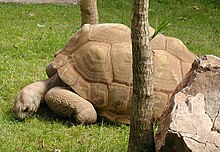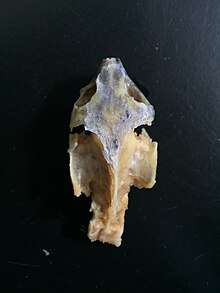Cryptodira
| Cryptodira Temporal range:
| |
|---|---|

| |
| Aldabra giant tortoise (Aldabrachelys gigantea) | |
| Scientific classification | |
| Domain: | Eukaryota |
| Kingdom: | Animalia |
| Phylum: | Chordata |
| Class: | Reptilia |
| Order: | Testudines |
| Suborder: | Cryptodira Cope, 1868[1] |
| Subgroups | |
|
See text | |
| Synonyms[1][2] | |
|
Cryptoderes Duméril and Bibron, 1834
| |


The Cryptodira (
Neck retraction
The Cryptodira are characterized by retraction of the head in the vertical plane, which permits for primarily vertical movements and restricted lateral movements outside of the shell.
Cryptodiran neck retraction is also dependent on associated cervical musculature for its characteristic motions. A study that focused solely on the mechanism of neck retraction in
Systematics and evolution
Cryptodires
The Cryptodira suborder has four living
Two circumscriptions of the Cryptodira are commonly found. One is used here; it includes a number of primitive
The alternate concept restricts the use of the term "Cryptodira" to the
As per the system used here, the Cryptodira can be classified as:[8][10]

- †Hangaiemys
- †Bashuchelyidae
- Pan-Cryptodira
- Family †Macrobaenidae? Sukhanov 1964
- Family †Xinjiangchelyidae? Nesov, 1990
- Family †Sinemydidae? Yeh, 1963
- Clade Pandurocryptodira
- Clade Americhelydia
- Clade Chelydroidea
- Family Chelydridae (snapping turtles)
- Superfamily Kinosternoidea
- Family Dermatemydidae (river turtles)
- Family Kinosternidae (mud turtles)
- Clade Panchelonioidea
- Clade †Angolachelonia?
- Clade †Thalassochelydia?
- Family †Eurysternidae?
- Family †Plesiochelyidae?
- Family †Thalassemydidae?
- †Owadowia?
- Family †Sandownidae? (may also belong in Thalassochelydia)
- Clade †Thalassochelydia?
- Family †Protostegidae? (may also belong in Thalassochelydia)
- Family †Toxochelyidae
- Family †Ctenochelyidae
- Superfamily Chelonioidea(sea turtles)
- Family Cheloniidae (green sea turtles and relatives)
- Family Dermochelyidae (leatherback sea turtles)
- Clade †Angolachelonia?
- Clade Chelydroidea
- Clade Pantestudinoidea
- Family †Lindholmemydidae?
- Superfamily Testudinoidea
- Family †Haichemydidae
- Family †Sinochelyidae
- Clade Emysternia
- Family Platysternidae(big-headed turtle)
- Family water turtles)
- Family
- Clade Testuguria
- Family roofed turtles)
- Family Testudinidae(tortoises)
- Family
- Clade Americhelydia
- Clade Pantrionychia
- Clade †Adocusia
- Family †Adocidae
- Family †Nanhsiungchelyidae
- Superfamily Trionychia
- Family Carettochelyidae (pignose turtles)
- Family Trionychidae (softshell turtles)
- Clade †Adocusia
Distribution
- Trionychidae (softshell turtles) are found from North America, Africa, South and East Asia to New Guinea.
- Kinosternidae (mud and musk turtles) are found from eastern North America to the Amazon drainage of South America.
- Dermatemydidae (Mesoamerican river turtles) are found in the Caribbean-Gulf drainage of Mesoamerica.
- Emydidae (cooters, sliders, American box turtles, and Allies) are found from Europe to Ural Mountains and North America southward to Eastern Brazil.
References
- ^ a b Rhodin 2011, p. 000.171
- ^ Rhodin 2008, p. 000.3
- PMID 28206991.
- ^ )
- ^ "ginglymoidy - oi". Archived from the original on 2020-01-31. Retrieved 2018-05-05.
{{cite journal}}: Cite journal requires|journal=(help) - ^ PMID 28501611.
- S2CID 15652309.
- ^ ISSN 1664-2384.
- S2CID 134736808.
- S2CID 85295987.
Further reading
- Baur, George (June 1890). "On the Classification of the Testudinata". The American Naturalist. 24 (282): 530–536. JSTOR 2450882.
- Rhodin, Anders G.J.; van Dijk, Peter Paul; Inverson, John B.; Shaffer, H. Bradley; Roger, Bour (2011-12-31). "Turtles of the world, 2011 update: Annotated checklist of taxonomy, synonymy, distribution and conservation status" (PDF). Chelonian Research Monographs. 5. Archived from the original (PDF) on 2012-01-31.
- Rhodin, Anders G.J.; van Dijk, Peter Paul; Parham, James F. (2008-12-08). "Turtles of the world, 2008 checklist" (PDF). Chelonian Research Monographs. 5. Archived from the original (PDF) on 2012-04-23. Retrieved 2012-05-22.
